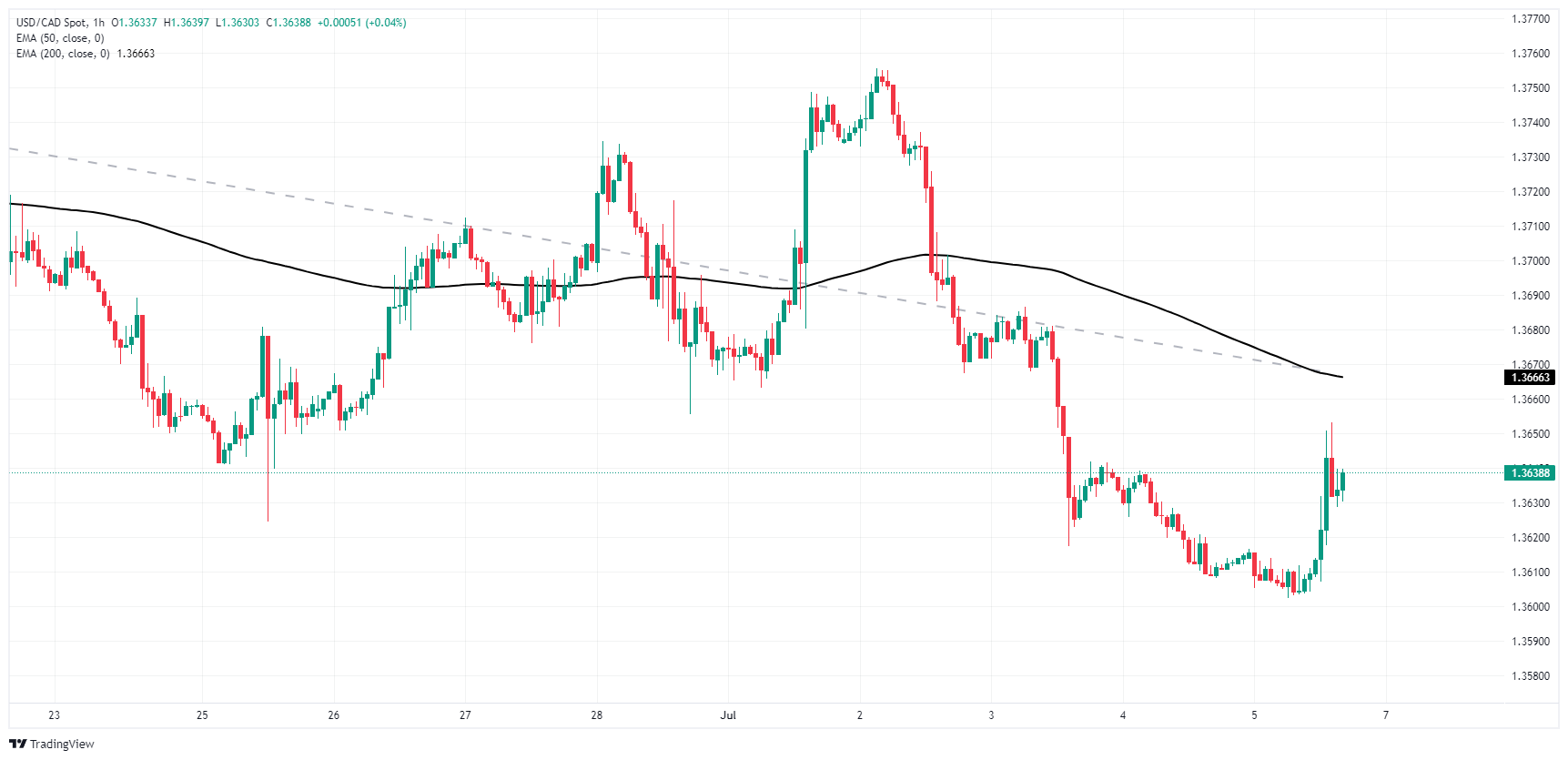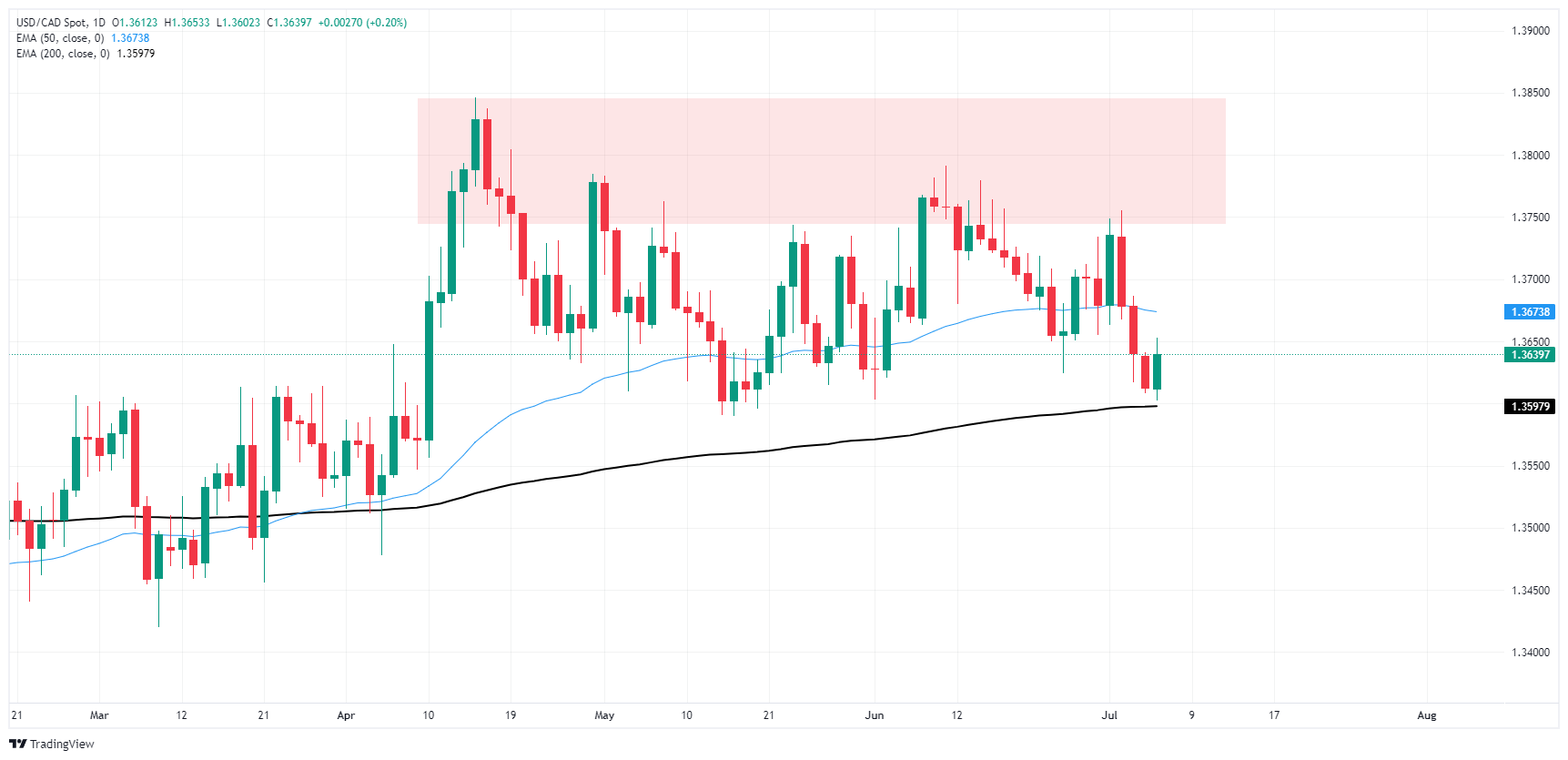- Analytics
- News and Tools
- Market News
- Canadian Dollar dumps on Friday after misfire in jobs data
Canadian Dollar dumps on Friday after misfire in jobs data
- Canadian Dollar backslides across the board after net jobs contract.
- Canada printed the second net negative jobs figure in 2024.
- Losses limited against the Greenback after sharp revisions to US NFP.
The Canadian Dollar broadly soured on Friday, getting pushed to the floorboards after Canadian Net Change in Employment printed a contraction for the second time in 2024 and missing forecasts by a wide margin. US Nonfarm Payrolls (NFP) beat forecasts, but steep revisions to previous figures helped to reignite hopes for a September rate cut.
Canada also reported a higher-than-expected increase in the Unemployment Rate. However, still rising wage pressures and increased Ivey Purchasing Managers Index (PMI) activity surveys bode poorly for future rate cuts as bellwethers of inflation pressures continue to build after the Bank of Canada (BoC) raced to cut rates in 2024.
Daily digest market movers: Canadian Dollar takes a dive as bad data sours risk-on chances
- Canadian Net Change in Employment in June sharply missed forecasts, printing at -1.4K MoM versus the previous 26.7K, far below the forecast of 22.5K.
- Canadian Unemployment Rate also ticked higher in June, rising to 6.4% from the previous 6.2%, running above the forecast for 6.3%.
- Canadian Average Hourly Wages rose 5.6% YoY in June, accelerating from the previous 5.2%.
- Canadian Ivey PMIs in June rose to 62.4 from the previous 59.1.
- US NFP net job gains handily beat forecasts, clocking in at 206K versus the forecast of 190K. However, the previous month’s figure was sharply revised lower to 218K from the initial print of 272K.
- US Average Hourly Earnings came in as expected, growing 3.9% YoY through June and cooling slightly from the previous 4.1%.
- With wage pressures easing and after-the-fact revisions chilling US NFP labor data, markets are again piling into bets of a September rate cut from the Federal Reserve (Fed). According to the CME’s FedWatch Tool, rate traders are pricing in nearly 80% odds of at least a quarter-point rate trim on September 18.
Canadian Dollar PRICE Today
The table below shows the percentage change of Canadian Dollar (CAD) against listed major currencies today. Canadian Dollar was the strongest against the US Dollar.
| USD | EUR | GBP | JPY | CAD | AUD | NZD | CHF | |
|---|---|---|---|---|---|---|---|---|
| USD | -0.13% | -0.31% | -0.24% | 0.18% | -0.20% | -0.29% | -0.26% | |
| EUR | 0.13% | -0.19% | -0.10% | 0.32% | -0.07% | -0.16% | -0.14% | |
| GBP | 0.31% | 0.19% | 0.10% | 0.52% | 0.13% | 0.03% | 0.03% | |
| JPY | 0.24% | 0.10% | -0.10% | 0.41% | 0.05% | -0.06% | -0.04% | |
| CAD | -0.18% | -0.32% | -0.52% | -0.41% | -0.39% | -0.46% | -0.47% | |
| AUD | 0.20% | 0.07% | -0.13% | -0.05% | 0.39% | -0.09% | -0.07% | |
| NZD | 0.29% | 0.16% | -0.03% | 0.06% | 0.46% | 0.09% | -0.01% | |
| CHF | 0.26% | 0.14% | -0.03% | 0.04% | 0.47% | 0.07% | 0.00% |
The heat map shows percentage changes of major currencies against each other. The base currency is picked from the left column, while the quote currency is picked from the top row. For example, if you pick the Canadian Dollar from the left column and move along the horizontal line to the US Dollar, the percentage change displayed in the box will represent CAD (base)/USD (quote).
Technical analysis: Canadian Dollar pares recent gains, snaps three-day win streak against Greenback
The Canadian Dollar (CAD) fell across the board on Friday, unceremoniously ending a three-day winning streak against the US Dollar (USD) and paring away Thursday’s gains as the CAD fell a fifth of a percent against the USD. An overall weaker US Dollar on Friday helped to limit losses, with the Canadian Dollar falling one-half of one percent against the Pound Sterling (GBP), Japanese Yen (JPY) and Swiss Franc (CHF).
USD/CAD retested 1.3650, rising from a near-term floor just above the 1.3600 handle, and bidders will be looking for a fresh break north of the 200-hour Exponential Moving Average (EMA) at 1.3666. Daily candlesticks continue to hold onto chart territory above 1.3600 as a consolidation pattern continues to build into the charts, and price action is getting squeezed by a supply zone priced in above 1.3750 and a rising 200-day EMA at 1.3591.
USD/CAD hourly chart
USD/CAD daily chart

Canadian Dollar FAQs
The key factors driving the Canadian Dollar (CAD) are the level of interest rates set by the Bank of Canada (BoC), the price of Oil, Canada’s largest export, the health of its economy, inflation and the Trade Balance, which is the difference between the value of Canada’s exports versus its imports. Other factors include market sentiment – whether investors are taking on more risky assets (risk-on) or seeking safe-havens (risk-off) – with risk-on being CAD-positive. As its largest trading partner, the health of the US economy is also a key factor influencing the Canadian Dollar.
The Bank of Canada (BoC) has a significant influence on the Canadian Dollar by setting the level of interest rates that banks can lend to one another. This influences the level of interest rates for everyone. The main goal of the BoC is to maintain inflation at 1-3% by adjusting interest rates up or down. Relatively higher interest rates tend to be positive for the CAD. The Bank of Canada can also use quantitative easing and tightening to influence credit conditions, with the former CAD-negative and the latter CAD-positive.
The price of Oil is a key factor impacting the value of the Canadian Dollar. Petroleum is Canada’s biggest export, so Oil price tends to have an immediate impact on the CAD value. Generally, if Oil price rises CAD also goes up, as aggregate demand for the currency increases. The opposite is the case if the price of Oil falls. Higher Oil prices also tend to result in a greater likelihood of a positive Trade Balance, which is also supportive of the CAD.
While inflation had always traditionally been thought of as a negative factor for a currency since it lowers the value of money, the opposite has actually been the case in modern times with the relaxation of cross-border capital controls. Higher inflation tends to lead central banks to put up interest rates which attracts more capital inflows from global investors seeking a lucrative place to keep their money. This increases demand for the local currency, which in Canada’s case is the Canadian Dollar.
Macroeconomic data releases gauge the health of the economy and can have an impact on the Canadian Dollar. Indicators such as GDP, Manufacturing and Services PMIs, employment, and consumer sentiment surveys can all influence the direction of the CAD. A strong economy is good for the Canadian Dollar. Not only does it attract more foreign investment but it may encourage the Bank of Canada to put up interest rates, leading to a stronger currency. If economic data is weak, however, the CAD is likely to fall.
© 2000-2024. All rights reserved.
This site is managed by Teletrade D.J. LLC 2351 LLC 2022 (Euro House, Richmond Hill Road, Kingstown, VC0100, St. Vincent and the Grenadines).
The information on this website is for informational purposes only and does not constitute any investment advice.
The company does not serve or provide services to customers who are residents of the US, Canada, Iran, The Democratic People's Republic of Korea, Yemen and FATF blacklisted countries.
Making transactions on financial markets with marginal financial instruments opens up wide possibilities and allows investors who are willing to take risks to earn high profits, carrying a potentially high risk of losses at the same time. Therefore you should responsibly approach the issue of choosing the appropriate investment strategy, taking the available resources into account, before starting trading.
Use of the information: full or partial use of materials from this website must always be referenced to TeleTrade as the source of information. Use of the materials on the Internet must be accompanied by a hyperlink to teletrade.org. Automatic import of materials and information from this website is prohibited.
Please contact our PR department if you have any questions or need assistance at pr@teletrade.global.















